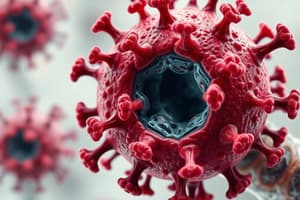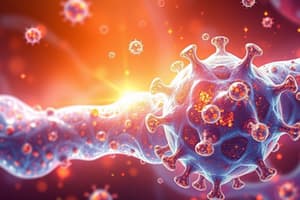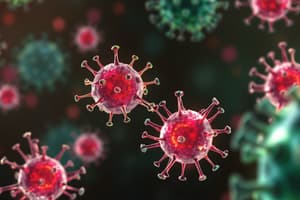Podcast
Questions and Answers
Which type of immunity/immune response handles intracellular antigens?
Which type of immunity/immune response handles intracellular antigens?
- Both humoral and cell-mediated immune responses
- Humoral immune response
- Cell-mediated immune response (correct)
- Innate immune response
What is the main role of the thymus in immunity?
What is the main role of the thymus in immunity?
- Production of antibodies
- Production of red blood cells
- Maturation of T cells (correct)
- Maturation of B cells
Which immunoglobulin class is the most abundant in the entire body?
Which immunoglobulin class is the most abundant in the entire body?
- IgG
- IgE
- IgA (correct)
- IgM
What is the relationship between plasma cells, B cells, and antibodies?
What is the relationship between plasma cells, B cells, and antibodies?
How do Tc cells kill on contact?
How do Tc cells kill on contact?
What is the primary difference between natural immunity and artificial immunity?
What is the primary difference between natural immunity and artificial immunity?
Which term refers to the process by which a disease develops?
Which term refers to the process by which a disease develops?
What is the primary difference between commensalism and mutualism?
What is the primary difference between commensalism and mutualism?
In Koch's postulates, what is the purpose of fulfilling all four postulates?
In Koch's postulates, what is the purpose of fulfilling all four postulates?
Differentiate between a symptom and a sign.
Differentiate between a symptom and a sign.
What distinguishes an endemic disease from an epidemic disease?
What distinguishes an endemic disease from an epidemic disease?
How does biological arthropod transmission differ from mechanical arthropod transmission?
How does biological arthropod transmission differ from mechanical arthropod transmission?
Why is a thrombocyte not a cell?
Why is a thrombocyte not a cell?
Differentiate between phagosome and phagolysosome.
Differentiate between phagosome and phagolysosome.
Define interferon and identify the cells that produce interferons and anti-viral proteins.
Define interferon and identify the cells that produce interferons and anti-viral proteins.
Explain the difference between chills, fever, and crisis, and the correct order in which they occur during an infection.
Explain the difference between chills, fever, and crisis, and the correct order in which they occur during an infection.
List three ways that microbes can evade phagocytosis.
List three ways that microbes can evade phagocytosis.
Describe the two families of leukocytes and their functions without focusing on their numerical abundance.
Describe the two families of leukocytes and their functions without focusing on their numerical abundance.
What is the relationship between LD50 and lethality & potency of the toxin?
What is the relationship between LD50 and lethality & potency of the toxin?
What is antigenic variation and how does it contribute to pathogenicity?
What is antigenic variation and how does it contribute to pathogenicity?
Differentiate between toxin, toxoid, and antitoxin.
Differentiate between toxin, toxoid, and antitoxin.
What is a nationally notifiable disease and list 2 STD examples from Table 14.6 that are nationally notifiable diseases.
What is a nationally notifiable disease and list 2 STD examples from Table 14.6 that are nationally notifiable diseases.
Describe the mechanism of pathogenicity including adherence, penetration/evasion, damage to the host, and exit.
Describe the mechanism of pathogenicity including adherence, penetration/evasion, damage to the host, and exit.
List 5 examples of adherence factors (adhesins) and include an example of a bacterium for each.
List 5 examples of adherence factors (adhesins) and include an example of a bacterium for each.
Flashcards are hidden until you start studying




